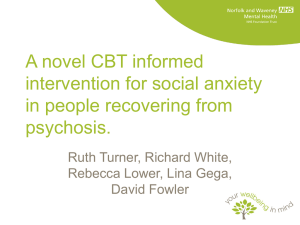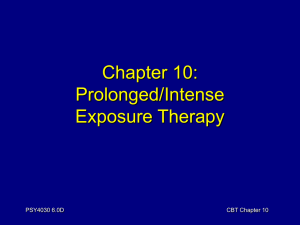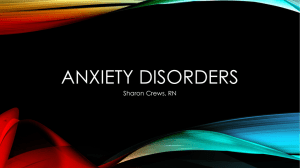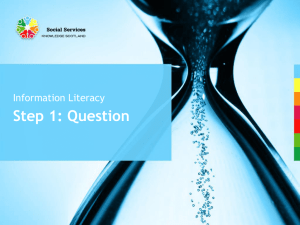CBT for Anxious Youth The Coping Cat Approach
advertisement
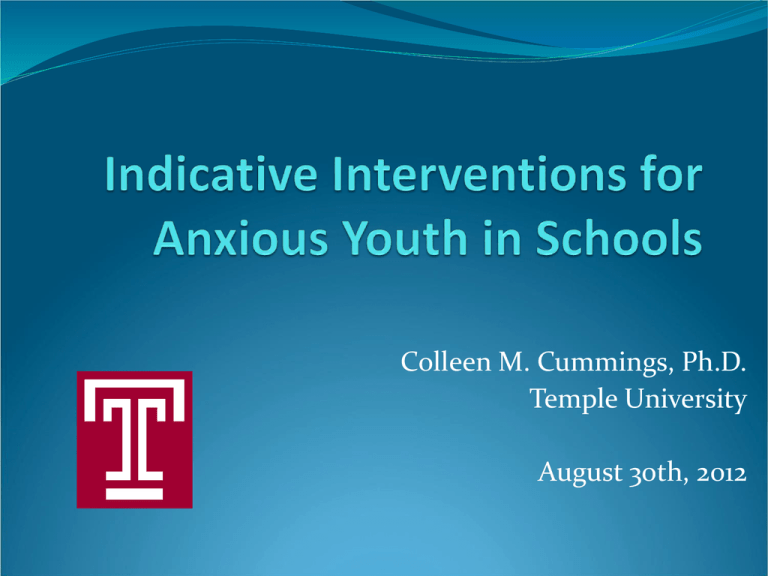
Colleen M. Cummings, Ph.D. Temple University August 30th, 2012 Overview Anxiety Disorders in Youth CBT model for Anxiety Interventions in Schools In General… Anxiety disorders among the most common mental health problems in youth Prevalence rates 10% to 20% (Chavira et al., 2004; Costello et al., 2004) Children with internalizing disorders (such as anxiety) receive treatment less frequently than those with externalizing problems (Garland et al., 2000) Anxiety disorders are frequently comorbid with other anxiety and depressive disorders, and some types of externalizing disorders Functional Impairment In children: Difficulties in peer relationships Poor academic achievement Commonly comorbid with other disorders In adults: Relationship impairment Physical health concerns Occupational disability Substance abuse Anxiety Disorders Separation Anxiety Disorder Generalized Anxiety Disorder Social Anxiety Disorder Specific Phobia Panic Disorder Agoraphobia Obsessive Compulsive Disorder Post Traumatic Stress Disorder Anxious Youth In Schools Problems may be less apparent than youth with behavioral disorders Children may appear perfectionistic; “good kids”; but can perform poorly in school (Mychailyszyn et al., 2010). Somatic complaints often frequent Especially in minority youth (Canino, 2004; Gee, 2004; Pina & Silverman, 2004) Anxiety can also present as oppositional behavior, such as through avoidance of tasks or school refusal School Refusal/Avoidance More than just “school jitters” Not to be confused with truant children Often symptom of deeper problem Affects 2-5% of children Up to 28% of youth refuse school at some time Most common ages affected: 5-6, 10-11, or in times of transition Children with school refusal tend to be of average or above average intelligence Impact of School Refusal Possible short term consequences include: Declining academic performance & social alienation Increased risk of legal trouble & financial expensve Family conflict, potential child maltreatment & lack of supervision Possible long term consequences include: Lower educational attainment & economic deprivation Occupational and marital problems Poor psychological functioning *Risk increases the longer the child remains out of school Types of School Refusal Hallmark – Heterogeneous condition Important – What is the function of school refusal behavior? To avoid school-related stimuli that provoke negative affectivity To escape aversive social situations To receive attention from others outside school To obtain tangible rewards outside school CognitiveBehavioral Therapy Work with patients to modify maladaptive thoughts, feelings and behaviors that develop and maintain psychological disorders. Feelings Thoughts Behaviors Behavioral Features Avoidance maintains and worsens anxiety. Tempting to avoid engaging with fears, but then child never fully experiences success over his/her fears Habituation: occurs when the child is in the presence of the feared stimulus for long periods of time Anxiety always decreases over time, and most often, the feared outcomes do not actually occur Operant learning perspective Anxiety and avoidance may be positively reinforced in the child’s environment Incorporating Cognitions Child’s sense of self-efficacy Belief that they can cope with a feared object Child’s cognitive biases, often reflecting: Low evaluations of competency to cope with danger(Bogels & Zigterman, 2000) High probability of negative outcomes/threat (Barrett et al., 1996) More likely to attend to emotionally threatening stimuli (Vasey & McLoed, 2001) The Role of the Family Anxious children often have anxious parents Genetic impact Anxious modeling Parents of children with anxiety disorders are theorized to be: More over-controlling/over-protective Less warm, more rejecting Overview of Coping Cat Program Part 1 Child learns when he is anxious Child learns coping skills F-E-A-R Plan Part 2 Exposures: gradual and repeated practices to feared situations 2 Parent Sessions School involvement (if necessary) Kendall, P. C., & Hedtke, K. (2006). Cognitive-Behavioral Therapy for Anxious Children: Therapist Manual (3rd ed.). Ardmore, PA: Workbook Publishing. www.WorkbookPublishing.com Part 1: Psychoeducation and Skill-building Build rapport; develop an understanding of his/her experience with anxiety Psychoeducation Recognizing feeling Physiological responses to anxiety Explore parent/family variables that contribute Skill-building Relaxation Training Cognitive techniques Problem-solving Self-examination and self-reward F E A R eeling frightened? xpecting Bad Things to Happen? ctions & Attitudes that can help esults & Rewards FEAR PYRAMID Part 2: Practice EXPOSURES: “We’ll go places and do things!” • Anxiety provoking situations • Aim is not to remove anxiety, but to be able to manage it, so child should experience anxiety. • Opportunity to practice • Gradual (step-by-step) • Repetition is key! • Stay in the situation until the anxiety decreases Exposures Collaborating Child knows exposure in advance and agrees In-session Preparation Make F-E-A-R Plan specific to the exposure Practice/Role-Play Processing Exposures How does the child think he/she did? Remember to reward the child after the exposure Exposures in and out of session CBT for Youth Anxiety CBT is considered to be evidence-based in the treatment of anxious youth (Silverman et al.,2008) Kendall and colleagues Three randomized controlled trials of Coping Cat with very positive results, including long-term maintenance of gains CAMS: 2009: 81% improved with combination CBT & SSRI, 60% with CBT alone, 55% with SSRI alone, 24% placebo Independent research teams find similar results Pharmacotherapy for Anxiety Disorders Medication SSRI’s, such as Zoloft®, help regulate neurotransmitters (chemical messengers in the brain) Generally well-tolerated Onset of effects takes about 4-8 weeks Approved by the Food and Drug Administration for children and adolescents with OCD Should be managed by a pediatrician or psychiatrist Dissemination of CBT • CBT for childhood anxiety is now a well-established treatment (Walkup et al., 2008) • Despite this, CBT is highly underutilized in the community (Gunter et al., 2010; Shafran et al., 2009) • The internalizing nature of anxiety may cause it to be overlooked • Exposure tasks may have misconceptions surrounding their use (Olatunji, Deacon & Abramowitz, 2009). • Many families may have limited access to care (Collins et al., 2004) • Important to consider organizational culture and climate before dissemination can take place (Glisson et al., 2008) Potential Reasons for Low Use Among U.S. children with emotional/behavioral problems, only 20-50% receive services (Farmer et al., 2003) Most of this is provided by schools (Canino et al., 2004), but is it evidence-based? Barriers to children’s mental health care in the U.S. often include: (Owens et al., 2002) Structural constraints (e.g., cost, transport, time) Stigmas surrounding mental illness Life stressors Levels of Intervention Universal Prevention: for entire populations Example: vaccinating all children under age 2 Selective Preventive Interventions: for those with risk factors Example: working with children of depressed mothers Indicated Preventive Interventions: for those at- risk exhibiting some symptoms Example: working with school-children who evidenced anxiety symptoms from a screener From Mzarek & Haggerty (1994) CBT in Schools Agencies around the world increasingly recognizing a link between children’s mental health and educational achievement US Surgeon General’s Report on Children’s Mental Health Council of Australian Governments UK Departments for Education and Skills and Children, Schools and Families Mychailyszyn et al. (2011); Elkins et al. (2011) Benefits of CBT in Schools Maximize access to interventions by reaching young people where they spend most of their time Increased opportunity for early detection/prevention Reduce common obstacles that typically prevent youth from receiving care Opportunities to intervene in the setting where problems most often occur (Ginsburg et al., 2008) Potential for greater impact on everyday lives of youth Often provides much more affordable care for families Barriers to CBT in Schools Questions regarding which CBT treatments to use and who can deliver them Universal prevention techniques require teachers Typically CBT programs call for rigorous training and ongoing supervision/support (Beidas & Kendall, 2010) Possibility for negative stigma/labels among youth receiving services Must promote mental health services without detracting from educational objectives Overcoming Barriers Utilize “flexible implementation” by studying school’s organizational culture and climate Consider alternative delivery models, such as computer-assisted CBT (Kendall et al., 2011) Perhaps teach CBT skills within the curriculum Distinguish between accommodations & interventions (Schultz et al., 2011) Work around school agendas and schedules (e.g. before/after school, during “specials”) Overcoming Barriers Adapt sessions to fit 30-minute time requirements Involve parents through phone calls and after-school meetings (Flanagan, 2011) Apply “stepped care” for youth with more severe & complicated presentations Problem-solve around difficulties with exposure tasks Findings on School-based CBT School-based anxiety interventions are generally effective compared to control (Mychailyszyn et al., in press) Skills for Social and Academic Success program (Masia Warner et al., 2007) FRIENDS program (Lowry-Webster et al., 2001) Cool Kids Program (Mifsud & Rapee, 2005) Modular CBT for anxious youth (Ginsburg et al., 2012) Future Directions Focus on feedback loops (Fixen, 2005) from the schools Importance of assessing organizational variables and approaching each school differently “Bottom-up” versus “Top-down” approach Determine modes of delivery most effective for schools Computer-assisted CBT Modular-based approaches What are the most effective training and supervision techniques (i.e., Stark et al., 2011 ) Overcoming barriers (e.g., limited time, resources)


